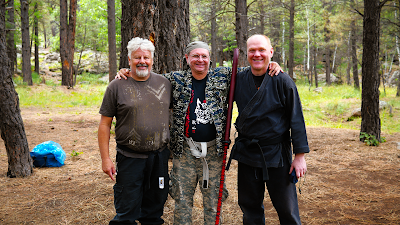From Bujinkan Santa Monica by Michael Glenn
 |
| Bujinkan Honbu Dojo and Summer Grasses, photo by Michael Glenn |
This was evident when I had a student read from the densho and show the technique. Then I showed the actual waza as I learned it from my teachers. There are many subtleties not contained in the densho that make the technique real and functional. Some of these are burned in my own memory from experiencing them in person, some I recover from my personal training notes.
For example, when striking with the boshi ken, there is a particular way to trace the anatomy to the target. This comes from Hatsumi Sensei who shared 切紙 急所説明 48穴当込みの場所 , 口伝。This art of paper cutting (kiri kami) is used to show the kyusho locations of 48 openings for striking, and it is a kuden (verbal transmission).
Another example comes from Soke’s use of 親殺 oya goroshi. I rarely see him do this kata without emphasizing this aspect. It has an out-sized effect on the outcome of this kata. But it is not in the densho.
To finish, I shared some of the feeling from my two Japan trips so far this year. We move beyond the waza to defeat the opponent using 繋がり tsunagari alone. The ability to do this supersedes all form. And it is one basis for the theme this year.
繋がり tsunagari means connection, link, or relationship. And maybe the most important connection in the Bujinkan is to the lineage of the art in Japan. Strive for the most direct connection possible. Go study there yourself, or study with a teacher who does. In my opinion, I think you should do both of those things.



